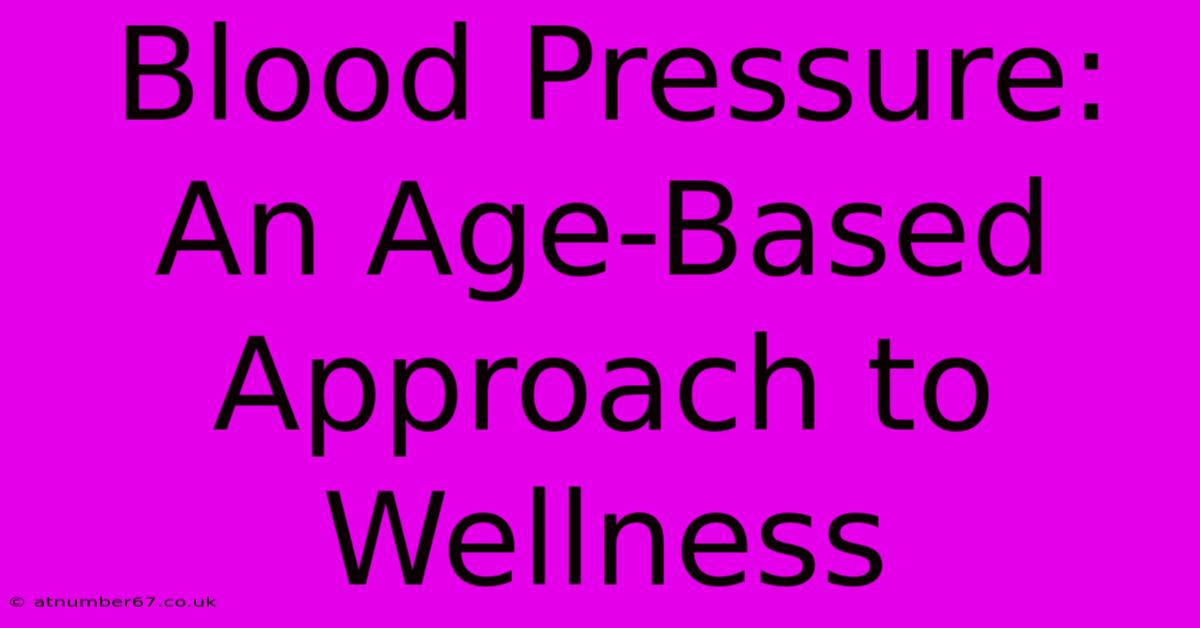Blood Pressure: An Age-Based Approach To Wellness

Table of Contents
Blood Pressure: An Age-Based Approach to Wellness
Maintaining healthy blood pressure is crucial for overall wellness, but the ideal approach varies throughout life. Understanding how blood pressure changes with age is key to proactive management and preventing serious health issues. This guide provides an age-based approach to understanding and managing your blood pressure.
Blood Pressure Basics: What You Need to Know
Before diving into age-specific considerations, let's review the fundamentals. Blood pressure is measured in two numbers: systolic (the top number) and diastolic (the bottom number). These numbers represent the pressure in your arteries when your heart beats (systolic) and rests between beats (diastolic). High blood pressure, or hypertension, is generally defined as consistently high readings, typically above 140/90 mmHg. However, the ideal target blood pressure can vary depending on individual health factors and age.
Understanding the Risks: Why Blood Pressure Matters
High blood pressure is a significant risk factor for numerous serious health problems, including:
- Heart attack: High blood pressure damages blood vessels, increasing the risk of clots and heart attacks.
- Stroke: High blood pressure weakens blood vessels in the brain, increasing the risk of stroke.
- Kidney disease: High blood pressure strains the kidneys, leading to potential damage and failure.
- Dementia: High blood pressure is linked to an increased risk of cognitive decline and dementia.
Regular blood pressure monitoring is essential for early detection and management of potential problems.
Blood Pressure Management: An Age-Based Approach
While the underlying principles of healthy blood pressure remain consistent, the strategies and target levels may differ throughout different life stages.
Childhood and Adolescence (Under 18): Building Healthy Habits
During these formative years, the focus should be on establishing lifelong healthy habits:
- Healthy Diet: Encourage a diet rich in fruits, vegetables, and whole grains, while limiting processed foods, sugary drinks, and excessive salt.
- Regular Exercise: Promote at least 60 minutes of moderate-to-vigorous physical activity most days of the week.
- Weight Management: Maintaining a healthy weight is crucial for preventing high blood pressure later in life.
- Limited Screen Time: Reducing screen time allows for more physical activity and better sleep.
Regular check-ups are important to monitor growth and development and identify any potential issues early on.
Adulthood (18-64): Proactive Monitoring and Lifestyle Changes
In adulthood, regular blood pressure checks become even more critical. Many adults develop prehypertension or hypertension without realizing it. Lifestyle modifications are often the first line of defense:
- Dietary Adjustments: Focus on the DASH (Dietary Approaches to Stop Hypertension) diet, rich in fruits, vegetables, whole grains, and lean protein. Reduce sodium intake significantly.
- Exercise Regimen: Aim for at least 150 minutes of moderate-intensity aerobic exercise or 75 minutes of vigorous-intensity aerobic exercise per week.
- Stress Management: Chronic stress contributes to high blood pressure. Incorporate stress-reducing techniques like yoga, meditation, or deep breathing exercises.
- Limit Alcohol: Moderate alcohol consumption (if at all) is recommended. Excessive alcohol intake raises blood pressure.
- Quit Smoking: Smoking significantly increases the risk of high blood pressure and cardiovascular disease.
If lifestyle modifications aren't enough, your doctor may prescribe medication.
Older Adulthood (65+): A More Nuanced Approach
Blood pressure management in older adulthood presents unique considerations:
- Lower Target Blood Pressure?: While the general recommendation for optimal blood pressure remains below 140/90 mmHg, some research suggests that for older adults, slightly higher readings might be acceptable, depending on individual health. This is a discussion best held with your doctor.
- Medication Considerations: The risk of medication side effects increases with age. Careful medication selection and monitoring are essential.
- Monitoring for Orthostatic Hypotension: Older adults are more prone to orthostatic hypotension (a sudden drop in blood pressure upon standing), which can cause dizziness and falls.
When to See a Doctor
Consult your doctor immediately if you experience:
- Severe headaches
- Shortness of breath
- Dizziness
- Chest pain
- Nosebleeds
- Vision changes
Regular blood pressure checks are essential, and these should be more frequent as you age. Don't hesitate to ask your doctor any questions or concerns you may have about your blood pressure. Proactive management throughout life can significantly reduce your risk of serious health complications. Remember, maintaining healthy blood pressure is a journey, not a destination. Consistency is key!

Thank you for visiting our website wich cover about Blood Pressure: An Age-Based Approach To Wellness. We hope the information provided has been useful to you. Feel free to contact us if you have any questions or need further assistance. See you next time and dont miss to bookmark.
Featured Posts
-
Dimitris Giannakopoylos From Rags To Riches
Apr 13, 2025
-
Kim Soo Hyun His Net Worth And Future Earnings
Apr 13, 2025
-
Whitneys Daughter A Reflection Of Resilience
Apr 13, 2025
-
Inner Child Healing A Journey To Self Acceptance
Apr 13, 2025
-
How Dangote Built His Empire Net Worth Explained
Apr 13, 2025
